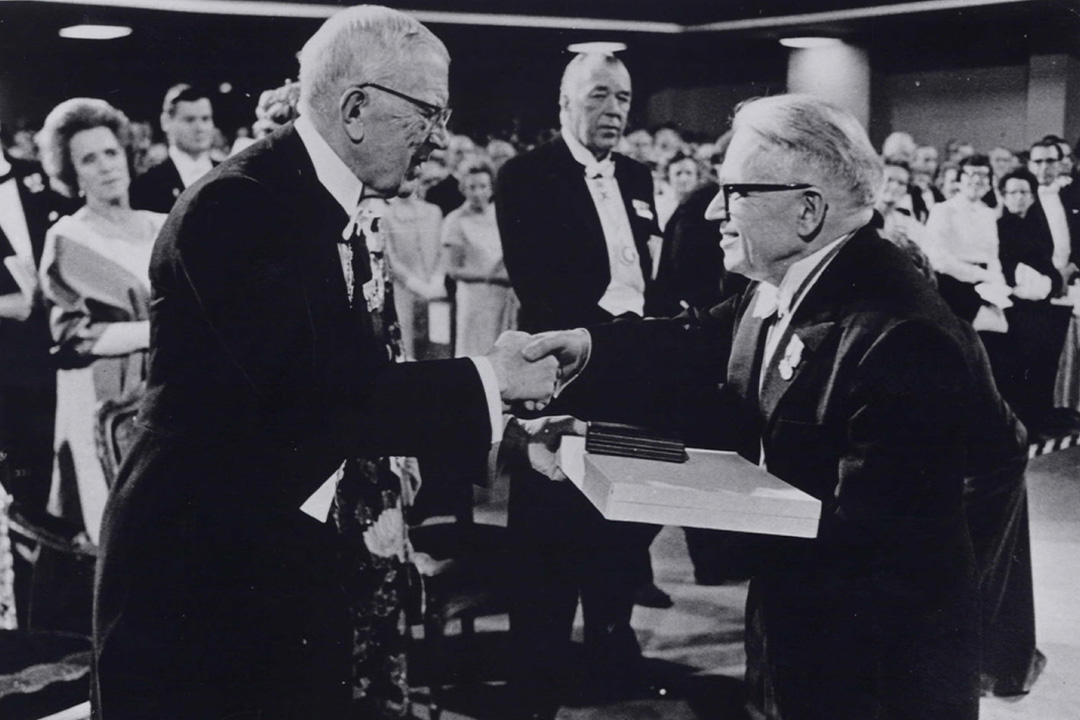
USask and CLS announce Herzberg Experimental Hall in honour of Nobel Laureate Gerhard Herzberg
As part of a national initiative to mark the 50th anniversary of Gerhard Herzberg’s Nobel Prize, the University of Saskatchewan (USask) is naming the main experimental hall of the Canadian Light Source (CLS) and a prominent physics lecture theatre on campus after the renowned scientist.
“Today—50 years to the month since Herzberg learned of his Nobel Prize—we are proud to commemorate a renowned Canadian scientist whose work on this campus, and later at the National Research Council (NRC) in Ottawa, has led to groundbreaking discoveries about the structure of molecules that have had, and continue to have, global impact,” said USask President Peter Stoicheff.
Refugees from Nazi persecution in 1935, Herzberg and his wife and fellow scientist Luise spent 10 productive years at USask. Three of Herzberg’s books were published during that time and are still considered classic works on atomic and molecular structure, advancing knowledge in chemistry, physics and astronomy.
“Canada and the University of Saskatchewan welcomed Herzberg and his wife when no other country or university did,” said Stoicheff. “His legacy is evident today in so many ways, including at our Canadian Light Source where scientists from across Canada and around the world continue to unravel the mysteries of atomic structure.”
The Herzberg Experimental Hall is at the heart of the CLS, “the brightest light in Canada.” The enormous hall the size of a football field houses the synchrotron which supplies light to the many beamlines where wide-ranging experiments are conducted. The naming was endorsed by both the CLS board of directors and the CLS Users’ Executive Committee, and subsequently approved by the President’s Advisory Committee on Naming University Assets.
“As the father of modern spectroscopy, Herzberg conducted experiments that fundamentally changed scientific understanding of how molecules absorb and emit light,” said CLS board chair Pierre Lapointe.
“So it is very fitting that we honour his legacy at the Canadian Light Source where scientists from across Canada and around the world carry on the important work of using light to investigate the structure of matter—work that is leading to discoveries in fields as diverse as health, environment and new materials.”
In his 2020 co-authored book on the history of the CLS, former CLS director Michael Bancroft said Herzberg’s fundamental research program in spectroscopy at USask in the 1930s paved the way for Canada’s only synchrotron. He states that the close friendship that developed between USask chemistry researcher John Spinks and Herzberg in 1933 and 1934 in Germany, along with Herzberg’s subsequent hiring by USask President Walter Murray in 1935, “were the most important events in eventually landing the Canadian Light Source over 60 years later.”
As Herzberg was a member of the USask physics department for a decade, the Physics 107 Lecture Theatre, across from a display dedicated to Herzberg, will be named the Dr. Gerhard Herzberg Lecture Theatre.
After Herzberg died in 1999 at age 94, the USask Herzberg Fund (now more than $2.7 million) was established with gifts from many donors who have provided scholarships, fellowships, and travel awards for more than 150 graduate students since 2004. Earlier this year, the USask chemistry department created a new student award—the Herzberg International Equity Award—which will assist close to 50 students from 20 countries this year alone.
In his Nobel acceptance speech, Herzberg thanked USask, acknowledging “the full and understanding support” of successive USask presidents and faculty who “did their utmost to make it possible for me to proceed with my scientific work.”
Many USask leaders, researchers and alumni have played a critical role in Herzberg’s story—one of an immigrant’s rise to Nobel prominence through bold curiosity, commitment to excellence, and scientific collaboration. Many of Herzberg’s USask students went on to illustrious research careers at the NRC, across Canada, and around the globe, including Henry Taube who went on to win a Nobel Prize himself. Visit a new USask website highlighting Herzberg’s life, science and USask connections: https://research.usask.ca/herzberg/
The naming announcements are in conjunction with “Herzberg50”, a national Herzberg50 project honouring the 50th anniversary of Herzberg’s 1971 Nobel Prize in Chemistry.
USask is partnering with the non-profit educational organization Defining Moments Canada, the National Research Council, Canadian Heritage, and other partners on Herzberg50, a major digital project that will showcase Herzberg’s life and achievements to a wide public audience including high school students. Herzberg50 inaugurates a larger commemoration project—NobelCanadian—honouring all Canada’s Nobel Laureates which will get underway in 2022-2023. USask has two Nobel Laureates, both in chemistry: Herzberg and Henry Taube.
2021 also marks the 50th anniversary of the German-Canadian Intergovernmental Agreement on Scientific and Technological Co-operation which has fostered more than 1,000 joint research projects.
USask and other Herzberg50 partners are working with the German Embassy on a Herzberg exhibit that will tour Canadian cities, starting with USask in January of 2022.

